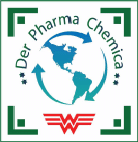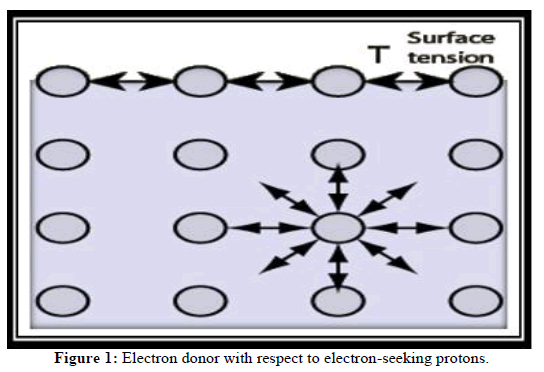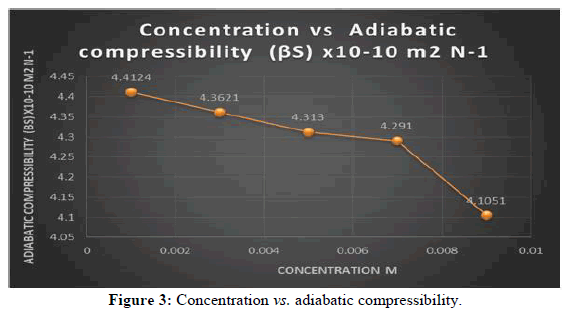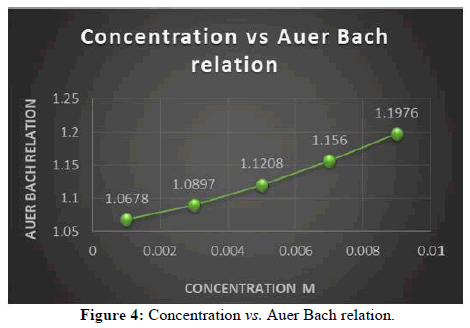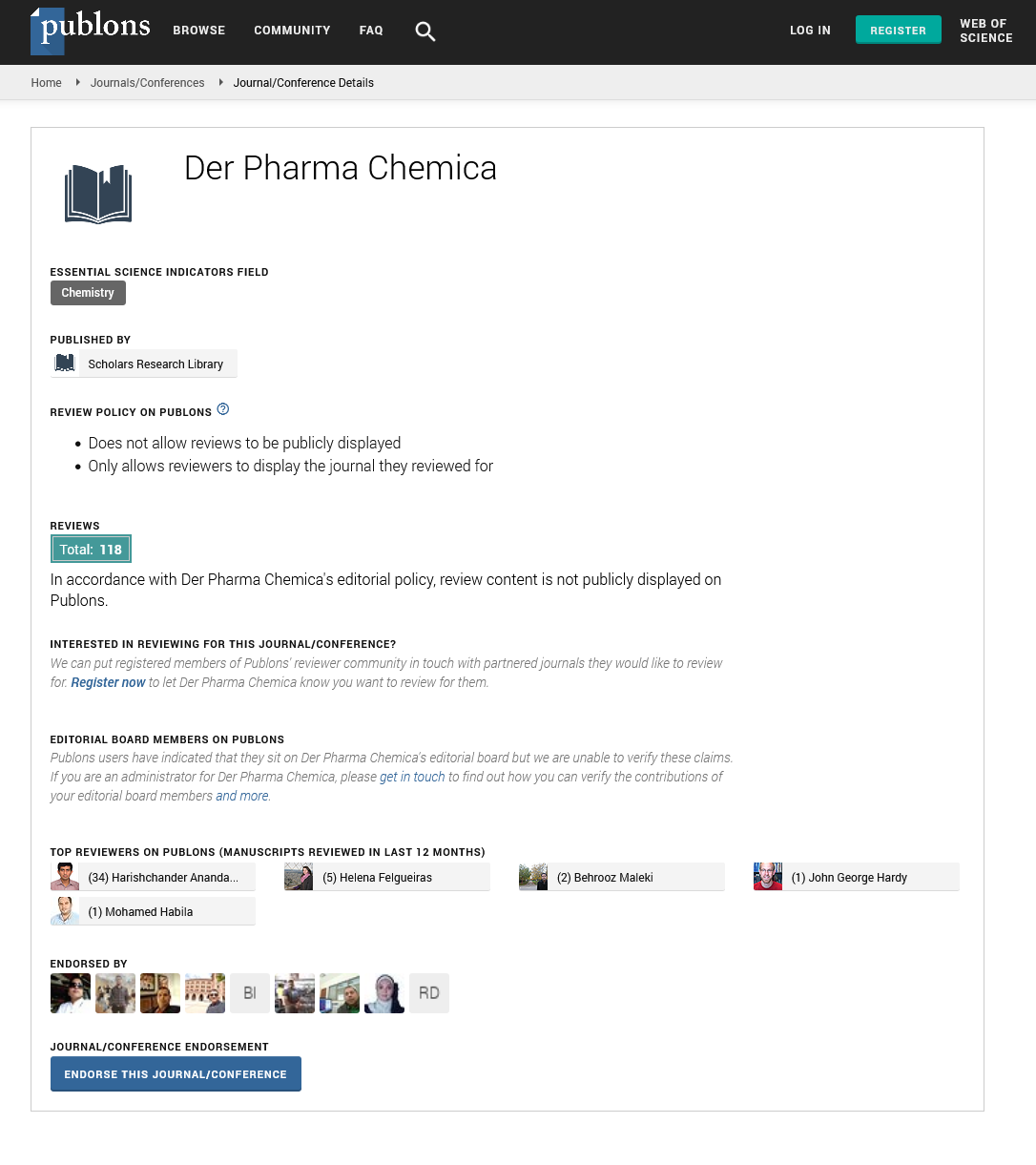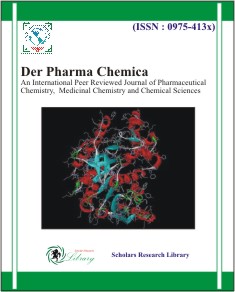Research Article - Der Pharma Chemica ( 2024) Volume 16, Issue 6
Analysis of Surface Tension on Schiff Base, 2-Amino 3-Hydroxy Pyridine and Dioxane at 303 K
D. Ubagaramary1* and Muthu Vijayan Enoch22Department of Nanoscience and Genomics, Karunya Institute of Technology and Sciences, Coimbatore, India
D. Ubagaramary, Department of Chemistry, Adhiyamaan College of Engineering, Bengaluru, India, Email: ubagaramary.chemistry@gmail.com
Received: 24-Oct-2024, Manuscript No. DPC-24-150847; Editor assigned: 29-Oct-2024, Pre QC No. DPC-24-150847 (PQ); Reviewed: 12-Nov-2024, QC No. DPC-24-150847; Revised: 01-Dec-2024, Manuscript No. DPC-24-150847 (R); Published: 29-Dec-2024, DOI: 10.4172/0975-413X.16.6.519-523
Abstract
The speeds of sound (U), density (ρ) and molar volume(M) of an aqueous solution of Schiff base, 2-amino,3-hydroxypyridine and dioxane are determined as a function of the molar fraction at 303 K. Different sound parameters such as compressibility (β), free volume (VF), internal pressure (πi) and acoustic impedance (Z) are calculated using it. The observed results are investigated in terms of structural changes around the ion and the impact they have on its surface tension and sound characteristics at 303 K.
Keywords
Ultrasonic spectroscopy; Surface tension; Schiff base and 2-amino 3-hydroxy pyridine
Introduction
Among the azole family, the most studied is heterogeneous. The compound is a five-membered pyrazole. The presence of active pyrazole nuclei in different structures is known to have almost all kinds of drug activities and has various applications in medicine. The chemicals are found in agriculture and technology and can act as glycoprotein inhibitors, antibacterial, antifungal, anticancer, antidepressant, anti-inflammatory, antituberculous and antioxidant. The most studied of the azole family is heterogeneous. The compound consists of a five-membered pyrazole. Pyrazoles with active nuclei in different structures have many different applications in medicine, such as antibiotics and antifungals. An interferometer is used to analyze the interactions between solvent and ions in an aqueous and non-aqueous medium. The device's interferometer provides a simple and direct method for determining ultrasonic velocity with high accuracy.
Models have recently shown usually important effects in determining the duration of solvent mixtures. Ultrasound absorption coefficient information. Furthermore, it is important to understand the physical and chemical properties of metallic bonding solutions to appreciate their theoretical importance in many industries. For example, fuels and petrochemicals are among these industries. The process of developing appropriate equipment to handle a variety of hazardous chemicals, including hydrocarbons, ketones, alcohols and aldehydes. It is essential to understand the soluble interactions of ions.
Literary reviews show that many researchers examine the ultrasonic properties of pyrazoline, amino acids and their derivatives in mixtures of solvents at different concentrations and at different temperatures. The structural properties of the complex were also studied by measuring ultrasonic properties and density [1].
Thermodynamic studies are also carried out with the help of interferometry technology. However, no study of Schiff's base has been performed under similar test conditions using 2-amino-3-hydroxypyridine and dioxane- as solvent. This draws our interest in studying the ultrasound properties of the Schiff base. Schiff base 2-amino-3-hydroxypyridinine and dioxane solvent mixture, temperature 303 K. Schiff's reagent refers to the term Schiff base, which refers to either secondary ketamine or secondary adimines, while Schiff's reagent refers to the reagent used to screen for aldehydes and ketones. Schiff bases are also used as catalysts, pigments, pigments, intermediates in organic synthesis, polymer stabilizers and corrosion inhibitors. This article discussed the density, velocity of sound and viscosity of Schiffs base under similar test conditions with 2-amino-3-hydroxypyridine and dioxane in an aqueous system of triple mixtures over the full synthesis range at T=303.15 K. The values of the generally pure components were determined. With available literary data. Based on the experimental data, many physical and chemical parameters of the components in infinite dilution were analyzed. The results were studied from the point of view of molecular interactions through dipole-induced dipole interactions between components of mixtures, which leads to the formation of electron-accepting complexes [2].
Materials and Methods
Experimental methods
Density measurement: All binary liquid mixtures were prepared by weighing an appropriate amount of pure liquid on an electric balance by means of a stopper bottle. The electronic equilibrium uncertainty was ± 0.01 mg but the molecular fraction accuracy was ± 1 × 10-4. An electronically actuated constant temperature bath was used to circulate water through a double-walled measuring cell composed of steel containing the experimental solution at the desired temperature, the accuracy of the temperature measurement being 0.01 K.
The density of pure liquids and their mixtures and electrolyte solution was measured using a 5 ml corning density canister by relative measurement. The volume of a bottle with specific gravity was determined by weighing it with double distilled water at experimental temperatures. Using the following relationship, we can determine the density of the unknown mixture at any temperature.

Where, ρw is the density of water, Ws and Ww is the weight of the unknown solution and water respectively. The density of pure liquids thus obtained was found to be in good agreement with the standard values.
Ultrasonic velocity measurement: Ultrasonic velocity measurements were carried out on an ultrasonic interferometer (model M 84, reported by M/S Mittal Enterprises, New Delhi) at T=303.15 K with an accuracy of ± 0.1 m/s. The measuring cell of the interferometer is a specially designed double-walled vessel taking into account temperature constancy. Electronically controlled constant temperature digital bath (model SSI-03 Spl, available from M/S Mittal Enterprises, New Delhi) operating over a temperature range of -10°C to 85°C with an accuracy of ± 0.1°C for circulation of water through the outer jacket of the double-walled measuring cell containing the experimental liquid [3].
Results and Discussion
The density, speed of sound and molecular volume of pure liquid mixtures with different molar fractions of Schiff base under similar testing conditions with 2-amino 3-hydroxy Pyrazidine and Dioxane presented in Table 1, Figures 1 and 2.
A calculation of the adiabatic compressibility (β) along with the internal pressure and acoustic impedance can be found in Table 1 and Figure 3 consequently.
| Concentration | Adiabatic compressibility | Intermolecular free length | Specific acoustic impedance |
|---|---|---|---|
| M | (βS) × 10-10m2N-1 | (Lf) × 10-11m | (Z × 106) kg m-2s-1 |
| 0.001 | 4.4124 | 4.2441 | 1.5168 |
| 0.003 | 4.3621 | 4.2105 | 1.5276 |
| 0.005 | 4.313 | 4.1736 | 1.5421 |
| 0.007 | 4.291 | 4.123 | 1.5583 |
| 0.009 | 4.1051 | 4.0746 | 1.5769 |
Table 1: Measured values of adiabatic compressibility (βS), intermolecular free length (Lf) and Specific acoustic impedance (Z).
Molar volume data are influenced by: Hydrogen bond breakage and loss of dipolar association due to differences in size and shape of dissimilar molecules and possible intermolecular interactions such as hydrogen bonding or donor-acceptor interactions between dissimilar molecules. The excess volume has a negative value for the of Schiff base under similar testing conditions with 2-amino 3-hydroxy pyridine and dioxane at T=303 K in the entire range of compositions and at all temperatures of the experiment. Negative VE values indicate the presence specific interactions, such as the interaction of hydrogen bonds between the mixing components, dipole-dipole or dipole-dipole induced interaction leading to electron donor-donor complexes [4,5].
There was a more ability for hydrogen bond interaction (O-H) between of Schiff base under similar testing conditions with 2-amino 3-hydroxy pyridine and dioxane. Furthermore, there was chance of electron donor-acceptor interactions between the electron donating atom of pyrazolone schizophrenia under similar testing conditions with 2-amino 3-hydroxy pyridine and dioxane. In such electron donor-acceptor interactions Schiff base acts as an electron donor. In the present study, interactions between of pyrazolone Schiff base under similar testing conditions with 2-amino 3-hydroxy pyridine and dioxane may be attributed to dipole-induced-dipole interactions between the components of the mixtures resulting the formation of electron donor-acceptor complexes. When oxygen atom of the Schiff base under similar testing conditions with 2-amino 3-hydroxy pyridine and dioxane was transferred the charges in the bond away from the ring to oxygen (mesmeric effect >inductive effect) leaving a positive charge in the ring. However, it was also donor in a donor-acceptor action. As a result of these two opposite effects, there can be a general transfer of a negative charge from the ring to the oxygen atom, as well as an increase in the acceptor character of Schiff base. Therefore, the interaction between of Schiff base under similar testing conditions with 2-amino 3-hydroxy pyridine and dioxane must be increased when oxygen and a hydroxyl atom are attached to the ring. As a result, Schiff base becomes a relatively electron donor with respect to electron-seeking protons of any group. The experimental results of the present study have confirmed this statement [6,7].
The adiabatic compressive data are given in Table 1 and Figure 3. And they are graphically shown in Figure 3. It is suggested that the decremented excess isentropic data for these systems are negative over the entire formation range at T=303 K.
The observed values can be explained qualitatively by considering factors (1) disruption of the associated molecular structures/arrangement in pure liquids, (2) formation of strong bonds by dipole-induced dipole interaction between molecules as opposed to molecules and (3) free The volume changes from mixing components of different sizes. The first factor contributes positive values, while the remaining two factors lead to negative values [8].
The positive values resulting from this system indicate that the net set of factors (2) and (3) do not dominate and this system is more compact. There is a volume contraction on the mixtures upon mixing, which can be attributed to dipole-induced dipole interactions resulting in electron-accepting complexes. However, as the temperature increases and becomes more negative, there are enhanced solute-type reactions between component molecules in Schiff phase similar testing conditions with 2-amino 3-hydroxy pyridine and dioxane [9].
Cohesion values were found to increase over the entire composition range at T=303 K for Schiff phase similar testing conditions with 2-amino 3-hydroxy pyridine and dioxane system. The observed values of β can be qualitatively explained by considering the cohesive forces between liquid Schiff phase similar testing conditions with 2-amino 3-hydroxy pyridine and dioxane system that are shared with all neighboring molecules of Schiff base. That surface has no atoms next to it above and exhibits stronger attractive forces on its nearest neighbor at the surface. This enhancement of intermolecular attraction on the surface of Schiff phase similar testing conditions with 2-amino 3-hydroxy pyridine and dioxane system is shown in Table 2 and Figure 4.
| Concentration | Auer Bach relation (s) Auer m N/m | Modified relation |
|---|---|---|
| M | m N/m 1018 | (s) Mod m N/m 1020 |
| 0.001 | 1.0572 | 1.0678 |
| 0.003 | 1.0789 | 1.0897 |
| 0.005 | 1.1097 | 1.1208 |
| 0.007 | 1.1446 | 1.156 |
| 0.009 | 1.1858 | 1.1976 |
Table 2: Measured values of Auer Bach relation and modified relation.
The surface tension data are given in Table 3 and graphically shown in Figure 5. It was found that the surface tension increases over the whole synthesis range at T=303 K, the surface tension arises from the polar nature of pyrazolone Schiff phase similar testing conditions with 2-amino 3-hydroxy pyridine and dioxane system. The liquid state of the molecule suffers from strong intermolecular attractive forces. When these forces are between similar particles, they are referred to as coherent forces. The dioxane molecules are held together by the cohesion force and especially strong cohesion forces on the surface of Schiff phase similar testing conditions with 2-amino 3-hydroxy pyridine and dioxane system.
| Concentration | Excess free volume | Excess internal pressure 106 | Cohesive force |
|---|---|---|---|
| 0.001 | -8.6324 | -2.0817 | 2.4344 |
| 0.003 | -8.0196 | -2.7566 | 2.4804 |
| 0.005 | -7.472 | -3.4315 | 2.5229 |
| 0.007 | -6.9802 | -4.1064 | 2.5628 |
| 0.009 | -6.5366 | -4.7813 | 2.5959 |
Table 3: Measured values of Excess free volume, excess internal pressure and cohesive force.
When intermolecular forces of attraction are as opposed to intermolecular, these are said to be adhesive forces. The adhesive forces between dioxane molecules with Schiff phase similar testing conditions with 2-amino,3-hydroxy pyridine and dioxane are stronger than the cohesive force that leads to contributing to capillary actions. These attractive forces between Schiff phase similar testing conditions with 2-amino,3-hydroxy pyridine and dioxane can be seen in the water system, residual electrostatic forces and van der Waal forces [10].
Conclusion
In this paper, we present densities, molar volumes and sound velocities of Schiff phase liquid mixtures with 2-amino 3-hydroxypyridine and dioxane systems at temperature=303 K. These values are generally consistent with published literature information. In infinite dilution, a number of physical and chemical parameters of the components were calculated using the experimental results. In order to understand the results, we analyze the molecular interactions between mixture components through dipole-inductive-dipole interactions that lead to electron-donor complexes. Due to its higher molecular mass, Schiff base diffuses less and is tightly adsorbed at the surface, causing a cohesive force effect to be observed on the surface. This increases the surface tension of Schiff phase under similar testing conditions with 2-amino 3-hydroxy pyridine and dioxane. At a higher concentration of Schiff phase, there is a strong intermolecular interaction between neighboring molecules, resulting in the formation of a strong film. Similar testing conditions are found with 2-amino-3-hydroxypyridine and dioxane. Surface tension plays an important role in many pharmaceutical processes from tablet coating to drug solubility and stability. Coatings on tablets are usually used to improve appearance, mask taste and odor or control the rate at which a drug is released.
Acknowledgements
We are thankful to the management of Adhiyamaan college of engineering, Hosur for providing the infrastructure as intimation for the improvement of research activities in the institute.
References
- Awasthi A, Rastogi M, Gupta M, et al. J Mol Liq. 1999; 80(1): p. 77-88.
- Seshagiri Rao MG, Ramachandra Rao B. Nature. 1961; 191(4784): p. 164-166.
- Vanathi V, Mullainathan S, Nithiyanantham S. J Chem. 2012; 9(1): p. 415-419.
- Nithiyanantham S, Palaniappan L. Asian J Chem. 2010; 22(7): p. 5413.
- Dominguez M, Pardo J, Santafe J, et al. Fluid Ph Equilib. 1996; 118(2): p. 227-240.
- Kharat SJ. J Chem Eng Data. 2008; 53(6): p. 1292-1294.
- Ubagaramary D. J App Chem. 2012; 2 (5) P. 01-19. [Crossref]
- Baruah B, Deb ML. Org Biomol Chem. 2021; 19(6): p. 1191-1229.
- Mahmudov KT, Pombeiro AJ. Chem: A European J. 2016; 22(46): p. 16356-16398.
[Crossref] [Google Scholar] [PubMed]
- Venkatraman S, Bogen SL, Arasappan A, et al. J Med Chem. 2006; 49(20): p. 6074-6086.
[Crossref] [Google Scholar] [PubMed]
